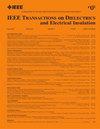Performance Evolution and Aging Mechanism of XLPE Insulation for HVdc Cables After Different Accelerated Aging
IF 2.9
3区 工程技术
Q2 ENGINEERING, ELECTRICAL & ELECTRONIC
IEEE Transactions on Dielectrics and Electrical Insulation
Pub Date : 2024-12-16
DOI:10.1109/TDEI.2024.3517568
引用次数: 0
Abstract
In this article, the ±200-kV crosslinked polyethylene (XLPE) cable used in Zhoushan flexible dc transmission project is targeted. Three accelerated aging schemes of continuous electrical (CE) aging, intermittent electrical (IE) aging, and electrothermal (TE) combined aging are designed, and the simulation test platform is built accordingly. The lamellar samples, cut from the XLPE insulation of the spare cable, are aged for predetermined durations under different design stresses. The samples are tested for oxidation induction time (OIT), Fourier transform infrared (FTIR) spectroscopy, differential scanning calorimetry (DSC), thermal stimulation current (TSC), space charge, dc conductivity, and dc dielectric strength, and the variation of various performance parameters are summarized. By analyzing the correspondence between the variation trend of each parameter and the aging process, the feature parameters that can effectively characterize dc XLPE insulation performance are determined, and the aging mechanism of dc insulation is explored. The results show that both electrical stress and thermal stress are important factors causing insulation aging, and their combined effect will significantly accelerate insulation deterioration. In addition, compared with the CE stress, the rise and fall of dc voltage will also aggravate the aging to a certain extent. Therefore, after the same time of continuous electrical stress, IE stress, and TE combined stress, the aging degree of XLPE samples increases in turn.不同加速老化后高压直流电缆 XLPE 绝缘层的性能演变和老化机理
本文以舟山柔性直流输电工程中使用的±200 千伏交联聚乙烯(XLPE)电缆为研究对象。设计了连续电老化(CE)、间歇电老化(IE)和电热组合老化(TE)三种加速老化方案,并建立了相应的模拟试验平台。从备用电缆的 XLPE 绝缘层上切割下来的薄片样品在不同的设计应力下进行预定时间的老化。对样品进行氧化诱导时间 (OIT)、傅立叶变换红外光谱 (FTIR)、差示扫描量热法 (DSC)、热刺激电流 (TSC)、空间电荷、直流导电率和直流介电强度测试,并总结各种性能参数的变化情况。通过分析各参数的变化趋势与老化过程之间的对应关系,确定了能有效表征直流 XLPE 绝缘材料性能的特征参数,并探讨了直流绝缘材料的老化机理。结果表明,电应力和热应力都是导致绝缘老化的重要因素,它们的共同作用会显著加速绝缘老化。此外,与 CE 应力相比,直流电压的升高和降低也会在一定程度上加剧绝缘老化。因此,在连续电应力、IE 应力和 TE 综合应力作用相同时间后,XLPE 样品的老化程度会依次增加。
本文章由计算机程序翻译,如有差异,请以英文原文为准。
求助全文
约1分钟内获得全文
求助全文
来源期刊
CiteScore
6.00
自引率
22.60%
发文量
309
审稿时长
5.2 months
期刊介绍:
Topics that are concerned with dielectric phenomena and measurements, with development and characterization of gaseous, vacuum, liquid and solid electrical insulating materials and systems; and with utilization of these materials in circuits and systems under condition of use.

 求助内容:
求助内容: 应助结果提醒方式:
应助结果提醒方式:


